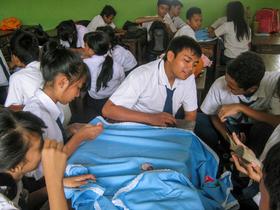Top Rankings
Lower Merion School District ranks among the top 20% of public school district in Pennsylvania for:
Category
Attribute
Overall Rank
Highest overall rank (Top 5%)
Math Proficiency
Highest math proficiency (Top 1%)
Reading/Language Arts Proficiency
Highest reading/language arts proficiency (Top 5%)
Science Proficiency
Highest science proficiency (Top 1%)
Graduation Rate
Highest graduation rate (Top 5%)
Diversity
Most diverse schools (Top 1%)
Community Size
Largest student body (number of students) (Top 1%)
Student Attention
Lowest student-teacher ratio (Top 1%)
For the 2025-26 school year, there are 2 public high schools serving 2,963 students in Lower Merion School District.
Public High Schools in Lower Merion School District have an average math proficiency score of 76% (versus the Pennsylvania public high school average of 30%), and reading proficiency score of 93% (versus the 58% statewide average).
Public High School in Lower Merion School District have a Graduation Rate of 97%, which is more than the Pennsylvania average of 88%.
The school with highest graduation rate is Harriton Sr. High School, with 97% graduation rate. Read more about public school graduation rate statistics in Pennsylvania or national school graduation rate statistics.
Minority enrollment is 35% of the student body (majority Black and Asian), which is less than the Pennsylvania public high school average of 39% (majority Black and Hispanic).
Overview
This School District
This State (PA)
# Schools
11 Schools
790 Schools
# Students
8,487 Students
641,839 Students
# Teachers
781 Teachers
46,794 Teachers
Student-Teacher Ratio
11:1
11:1
Student By Grade
District Rank
Lower Merion School District, which is ranked within the top 5% of all 678 school districts in Pennsylvania (based off of combined math and reading proficiency testing data) for the 2022-2023 school year.
The school district's graduation rate of 97% has stayed relatively flat over five school years.
Overall District Rank
#7 out of 685 school districts
(Top 5%)
(Top 5%)
Math Test Scores (% Proficient)
79%
38%
Reading/Language Arts Test Scores (% Proficient)
86%
55%
Science Test Scores (% Proficient)
87%
57%
Graduation Rate
97%
87%
Students by Ethnicity:
Diversity Score
0.56
0.59
% American Indian
n/a
n/a
% Asian
12%
4%
% Hispanic
6%
15%
% Black
9%
15%
% White
64%
61%
% Hawaiian
n/a
n/a
% Two or more races
9%
5%
All Ethnic Groups
District Revenue and Spending
The revenue/student of $34,093 is higher than the state median of $23,696. The school district revenue/student has stayed relatively flat over four school years.
The school district's spending/student of $35,337 is higher than the state median of $23,119. The school district spending/student has stayed relatively flat over four school years.
Total Revenue
$289 MM
$39,541 MM
Spending
$300 MM
$38,578 MM
Revenue / Student
$34,093
$23,696
Spending / Student
$35,337
$23,119
Best Lower Merion School District Public High Schools (2025-26)
School
(Math and Reading Proficiency)
(Math and Reading Proficiency)
Location
Quick Facts
Rank: #11.
Harriton Sr. High School
(Math: 78% | Reading: 91%)
Rank:
Rank:
10/
Top 5%10
600 N Ithan Ave
Bryn Mawr, PA 19010
(610) 658-3950
Bryn Mawr, PA 19010
(610) 658-3950
Gr: 9-12 | 1,206 student Student-teacher ratio: 10:1 Minority enrollment: 31%
Rank: #22.
Lower Merion High School
(Math: 74% | Reading: 94%)
Rank:
Rank:
10/
Top 5%10
315 E Montgomery Ave
Ardmore, PA 19003
(610) 645-1810
Ardmore, PA 19003
(610) 645-1810
Gr: 9-12 | 1,757 student Student-teacher ratio: 12:1 Minority enrollment: 37%
Recent Articles

Charter Schools vs Public Schools 2025: Key Differences & Trends
Explore updated 2025 insights comparing charter schools vs public schools, enrollment, academic outcomes, funding, and real-world examples for families and educators.

Are Public Schools Ready for the 21st Century? 2025 Update
Explore 2025 insights on whether public schools are ready for the 21st century, covering performance, technology, equity, funding, and future-ready learning.

Public School Open House & Enrollment Season Guide
A parent-focused guide to the public school open house and enrollment season, with expert questions, timelines, and decision tips.





